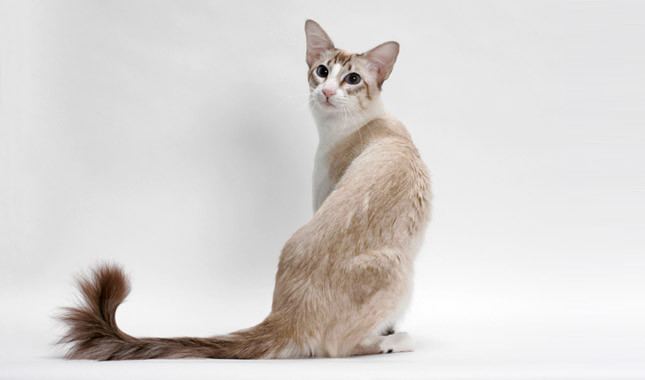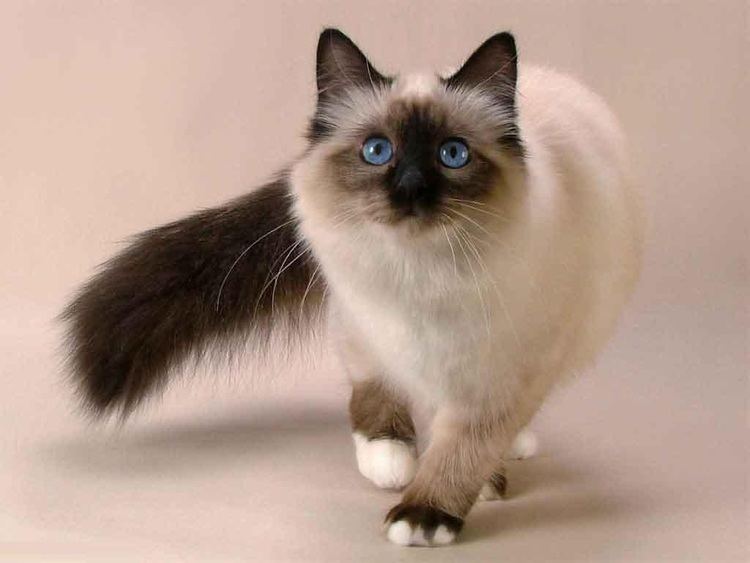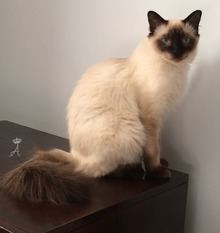Other names Long-haired Siamese FIFe standard ACF standard Scientific name Felis catus Higher classification Cat | CFA standard TICA standard ACFA/CAA standard Rank Breed | |
 | ||
Similar Ocicat, Japanese Bobtail, Tonkinese cat, Abyssinian cat, American Curl | ||
The Balinese is a long-haired breed of domestic cat with Siamese-style point coloration and sapphire-blue eyes. The Balinese is also known as the purebred long-haired Siamese, since it originated as a natural mutation of that breed, and hence is essentially the same cat with a medium-length silky coat and a distinctively plumed tail.
Contents
- The balinese cat cutest cat breeds cat facts
- History and development
- Appearance
- Coat and color
- Temperament
- Hypoallergenic claims
- Genetics
- References

As is the case with their short-haired counterparts, a genetic distinction is made between traditional or "old-style" and modern body types. In the American standard, colour variants derived from the Colourpoint Shorthair are further considered a separate breed, known as the Javanese. There is no particular connection between these cats and the Indonesian islands of Bali and Java, from which they derive their names.

Like their Siamese ancestors, Balinese are sociable, vocal, playful and inquisitive, and considered among the most intelligent of all long-haired breeds.

The balinese cat cutest cat breeds cat facts
History and development
The "Balinese" is not actually from Bali or any part of Indonesia. Its history begins with the first Siamese cats that were imported from Thailand to the U.S. and UK in the mid-1800s, some of whom carried the recessive long-haired gene. The Balinese breed subsequently originated from deliberate breeding efforts based around this naturally expressed genetic trait.
Initially, occasional long-haired kittens in Siamese litters were considered a fault in the bloodlines and sold exclusively as pets. There are records of these cats as early as the 1920s; "Long-haired Siamese" were first registered as show cats with the American Cat Fanciers Federation (CFF) in 1928. In the mid-1950s, breeders in the US began serious efforts to develop the long-haired variant as a separate breed. Considering Long-haired Siamese too cumbersome a name, initial breeder Helen Smith dubbed the new breed "Balinese" as a reference to the grace of Balinese dancers.
A breeder named Sylvia Holland worked to further establish the breed standard in the 1960s and 1970s. She recognized only cats showing the classic Siamese points in seal, chocolate, blue and lilac as true Balinese, refusing to accept others on the grounds that they had likely originated from crosses with other breeds. The American Cat Fanciers' Association (CFA) had meanwhile officially classified Siamese with the newer red and cream as well as lynx (tabby) and tortoiseshell (or "tortie") patterned points as a separate breed, the Colourpoint Shorthair, and the long-haired cats derived from these colors and patterns were subsequently likewise classified separately as "Javanese", in keeping with the Indonesian island theme.
Like their Siamese ancestors, the Balinese gradually split into two separate varieties based on physical type The traditional Siamese (also called old-style or "apple-head", now being separately developed as the Thai), was the type in vogue when the Balinese was established, and hence used in its development; these old-style Balinese still closely resemble those from the early breeding programs.
As the parent short-haired Siamese gained in popularity, however, a trend developed in favor of a more extremely elongated, slender type with a distinctively wedge-shaped head. The modern (or "contemporary") Balinese was subsequently derived directly from this newer Siamese ideal. By the mid-1980s, the old-style Balinese, like their Siamese counterparts, had disappeared from most cat shows, with the exception of a few breeders who maintained the original Balinese type. The two varieties of Balinese thus have very few if any recent ancestors in common.
Appearance
The two types of Balinese are still analogous to their Siamese counterparts. While both are relatively slender, graceful fine-boned cats with long legs and tail, neat oval paws, almond-shaped eyes and large pointed ears, the traditional type is overall the more substantial, with a broader head and sturdier body. The modern type features a noticeably more wedge-shaped head with long tapering muzzle and longer, broader ears, atop a more slender and elongated body.
Coat and color
The coat is basically medium-length (although there can be considerable variance by individual) and should be soft and silky, without the fluffy undercoat typical of most long-haired breeds. The offspring of two Balinese will have a longer coat than that of a Balinese and a Siamese. In all cases, the tail should have a definite plume, or fringe, of longer hair. Eye color ranges from pale blue through sapphire/violet; intensity of color can change slightly with age and diet. The paw pad color can be used to identify the color point in kittens. Pink pads are found in chocolate and lilac points; while dark pads are found in blue and seal points.
Like all cats with the point pattern, Balinese kittens are born pure cream or white and gradually develop visible points in colder parts of their body — the face, ears, paws and tail. Their color is identifiable by the time they are four weeks old. Some cats tend to darken with age, and generally, adult Balinese cats living in warm climates have lighter coats than those in cool climates.
The CFF and most other associations worldwide accept the Balinese breed in seal, blue, chocolate, lilac, red and cream point, besides tortoiseshell and lynx points in all of these colors. The CFA standard continues to accept the Balinese in only the classic seal, blue, chocolate and lilac points, with all other possible colors and patterns classed separately as Javanese.
Temperament
Balinese share the traits of the short-haired Siamese, and hence are notably social and playful cats with an intense interest in the activity around them and a tendency to vocalise often and persistently, albeit at a lower volume. They are reputed to have the highest intelligence of all the long-haired breeds. They are also reputed to be notably acrobatic, and to enjoy intimate contact with their owners.
Hypoallergenic claims
Anecdotally, Balinese are claimed to cause many fewer problems with allergies than most breeds. While strict scientific evidence for this is lacking, it has been determined that, in comparison to most cats, the Balinese produces very low amounts of the Fel d1 and Fel d4 protein allergens. As with the Siberian cat breed, some Balinese breeders and clubs are working together to produce more rigorously tested evidence of the Balinese's hypoallergenic quality.
Genetics
The pointed pattern [1] is a form of partial albinism, resulting from a mutation in tyrosinase, an enzyme involved in melanin production. The mutated enzyme is heat-sensitive; it fails to work at normal body temperatures, but becomes active in cooler areas of the skin. This results in dark coloration in the coolest parts of the cat's body, including the extremities and the face, which is cooled by the passage of air through the sinuses. Though crossbreeding with other breeds took place in order to produce the less traditional Javanese colors, they are considered purebred cats if they are registered and have at least 3-4 or more generations of Siamese or Balinese lineage.
